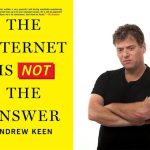Dorian Gray, a young man abandoned to a sensual lifestyle, commissions an artist to paint him a life-size portrait.
As Gray rakes himself with pleasure, the mythic picture bears the marks, while he persists in the prime of youth.
One day, being shown the paper trail of his pleasure-intoxication on the now diminished portrait, the young man stabs the artist for unveiling his condition.
Blood gushes out of the picture, the atrociously pixelated profile of his soul. Gray frantically stabs the portrait upon which he falls lifeless on the floor.
This merging of life and image in Oscar Wilde’s novel, “A Picture of Dorian”, is a grain of fact in fiction.
According to philosopher Ravi Zacharias, the image can be impinged on the senses as reality, collapsing fiction into fact, picture into passion, thinking into living.
“A picture takes on a life of its own and sometimes supplants life,” Zacharias observes.
If image influences reality, this may well explain the emotional investment in the representation of Africa at home and abroad.
Defining Africa has long been a site of contest and the motivation behind successive cultural projects.
Ten writers table the problem in the laboratory of social science in “Images of Africa: Creation, Negotiation and Subversion”.
The 2015 book, edited by Julia Gallagher, traces the battles of the image of Africa from pre-colonial times to the present.
The classic Pan-Africanists contend that the European view of Africa was deliberately distorted to mark out the continent for imperial interventions.
The image of a dark Africa lost in a time warp was famously, reinforced by travel journals and works such as Joseph Conrad’s “Heart of Darkness”, set up the continent for prescriptive civilisation at the hands of European crusaders.
Africa has remain the subject of condescending images, with the classic template of a continent without domestic agency persisting beyond independence.
Gallagher refers to the persistent depictions of Africa as “corrupt, malnourished, full of diseased children, conflict and crime, from internet scams to piracy”.
In the post-colonial scenario, the moral obligation to save Africa from itself has been taken up by development agencies, benevolent pop stars and foreign journalists, taking over from explorers, missionaries, anthropologists and colonial officials.
Africans have activated cultural outlets including literature, news media and political movements to speak back to the empire but old stereotypes seem to dominate discourse.
“Images of Africa” interrogates how the initiatives meant to supplant artificial and imposed images with authentic and homegrown ones have often fallen short and proposes a more nuanced approach to the task.
A BBC debate titled “Should Africa Employ Lobbyists?” cited by Gallagher demonstrates the politics of image in post-colonial Africa.
For the affirmative, a PR manager argues that an African country like DRC needs brand management because labels such as “rape capital of the world”, a reputation for corruption, loss of four million lives in civil war are bound to forestall investment and development funds.
On the other hand, a human rights activist argues that brand management can be used to gloss over abuse, crime and corruption, and to make governments immune to criticism.
For Gallagher, this brings about two impressions: the power of the images, its ability to draw in aid, hide crime and change reality on one hand; and its malleability in the hands of the creator on the other hand.
It, therefore, matters who owns the image and to what interest. However, Gallagher cautions against playing into an assumption of an omnipotent or totally malleable image.
She argues that an either purely Western or purely African invention of image falters since persuasive images are created in the context of existing relationships.
Image creation must tap into the consumer’s imaginative map, instead of simulating rigid and equally artificial counter-stances, in order to be persuasive.
Gallagher argues that the static approach presented espoused by advocacy literature sells writing back short because it emphasises the power of the subject in isolation from the viewer.
While African actors have agency in image creation, it is continually moderated by its observers or consumers, hence the need for a more historically nuanced approach rather than a homogeneous and valourised epic.
George Ogola revisits the stillborn vision of a Pan-African media initiative encompassing the continent, and proposes a vista of experiences that embraces a heterogeneous definition of the continent.
Ogola says early initiatives failed because they played into the hands of African elites who focused on brand management rather than capturing the continent’s various shades and sensibilities.
Early demands for an equitable media environment was staged as the New World Information and Communication Order (NWICO) debate at UNESCO by the Pan-Africanist fathers riled by the linear flow of news from the global north to the developing world.
Africa, systematically underdeveloped by slavery and colonisation, had to be incentivised in setting up media infrastructure on the same level with Europe and North America.
NWICO was stifled when Britain and the US threatened to withdraw funding from UNESCO but it had set the stage for Pan-African media initiatives, particularly the Pan-African News Agency.
Ogola says the Pan-African initiative did not strike the right mix because they rode roughshod over internal differences, undermining their founding cause of enabling diverse narratives in response to a West-packaged homogenous image of Africa.
He juxtaposes PANA and SABC Africa with Nollywood and MultiChoice Africa which have scaled up to the global stage because they have anticipated the complexity of the market and the agency of the viewer.
“Media policies and debates on the pan-African media agenda must be located within a broader and more complex matrix that transgresses current populist imaginations of the continent,” Ogola said.
“The relative successes of MultiChoice Africa and Nollywood demonstrate two ways which this project might be pursued. It is clear that the market, the affective experience of the consumer, too, plays a critical role in the construction or the shaping of image – of Africa as of anything else,” he argues.
Mel Bunce looks at a recent development whereby Western media institutions have been contracting more local correspondents in Africa in place of foreign reporters and considers if it has resulted in a new image of Africa, detached from traditional stereotypes.
She observes that while local correspondents are more emotionally invested and historically engaged in their coverage, they are still muzzled by house policy. Because they are driven by the need to sell more stories, they are prone to play into the Western image of Africa.
She, however, acknowledges alternative outlets such as Al Jazeera English and Twitter for enabling local voices to debate the contemporaneous image of Africa to the global audience.
“Images of Africa” is an engaging read for its nuanced and pragmatic approach towards the construction of an alternative image of Africa.







